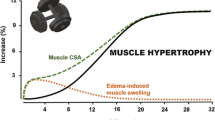Abstract
This study determined the effects of heat shock protein 70 (Hsp70) overexpression on disuse muscle atrophy in senescent rats. Solei of young and senescent rats were co-injected with Hsp70 plus a nuclear factor kappa B (NF-κΒ) reporter plasmid. After 4 days, the hind limbs of half the young and senescent rats were immobilized for 6 days with the remainder serving as weight bearing controls. Hsp70 protein levels and cross-sectional area decreased in both groups (~20%) after immobilization. Atrophy was prevented in those fibers overexpressing Hsp70. NF-κΒ activity increased in the soleus of both young (three-fold) and senescent (five-fold) animals after immobilization and was prevented by Hsp70 overexpression. Inhibitor of κΒ decreased in young (~30%) and senescent (~10%) animals with immobilization and returned to normal with Hsp70. Heat shock protein 70 overexpression prevents disuse atrophy in senescent rats, possibly through suppression of the NF-κB pathway.






Similar content being viewed by others
References
Alzghoul MB, Gerrard D, Watkins BA, Hannon K (2004) Ectopic expression of IGF-I and Shh by skeletal muscle inhibits disuse-mediated skeletal muscle atrophy and bone osteopenia in vivo. FASEB J 18:221–223
Bar-Shai M et al (2005a) The effect of hindlimb immobilization on acid phosphatase, metalloproteinases and nuclear factor-kappaB in muscles of young and old rats. Mech Ageing Dev 126:289–297. doi:10.1016/j.mad.2004.08.030
Bar-Shai M, Carmeli E, Reznick AZ (2005b) The role of NF-kappaB in protein breakdown in immobilization, aging, and exercise: from basic processes to promotion of health. Ann N Y Acad Sci 1057:431–447. doi:10.1196/annals.1356.034
Boonyarom O, Inui K (2006) Atrophy and hypertrophy of skeletal muscles: structural and functional aspects. Acta Physiol (Oxf) 188:77–89. doi:10.1111/j.1748-1716.2006.01613.x
Booth FW, Kelso JR (1973) Production of rat muscle atrophy by cast fixation. J Appl Physiol 34:404–406
Broome CS et al (2006) Effect of lifelong overexpression of HSP70 in skeletal muscle on age-related oxidative stress and adaptation after nondamaging contractile activity. FASEB J 20:1549–1551. doi:10.1096/fj.05-4935fje
Cai D et al (2004) IKKbeta/NF-kappaB activation causes severe muscle wasting in mice. Cell 119:285–298. doi:10.1016/j.cell.2004.09.027
Chakravarthy MV, Davis BradleyS, Booth FrankW (2000) IGF-I restores satellite cell proliferative potential in immobilized old skeletal muscle. J Appl Physiol 89:1365–1379
Hunter RB, Kandarian SC (2004) Disruption of either the Nfkb1 or the Bcl3 gene inhibits skeletal muscle atrophy. J Clin Invest 114:1504–1511
Hunter RB, Stevenson E, Koncarevic A, Mitchell-Felton H, Essig DA, Kandarian SC (2002) Activation of an alternative NF-kappaB pathway in skeletal muscle during disuse atrophy. FASEB J 16:529–538. doi:10.1096/fj.01-0866com
Judge AR, Koncarevic A, Hunter RB, Liou HC, Jackman RW, Kandarian SC (2007) Role for IkappaBalpha, but not c-Rel, in skeletal muscle atrophy. Am J Physiol Cell Physiol 292:C372–C382. doi:10.1152/ajpcell.00293.2006
Krawiec BJ, Frost RA, Vary TC, Jefferson LS, Lang CH (2005) Hindlimb casting decreases muscle mass in part by proteasome-dependent proteolysis but independent of protein synthesis. Am J Physiol Endocrinol Metab 289:E969–E980. doi:10.1152/ajpendo.00126.2005
Larsson L, Grimby G, Karlsson J (1979) Muscle strength and speed of movement in relation to age and muscle morphology. J Appl Physiol 46:451–456
Larsson L, Li X, Frontera WR (1997) Effects of aging on shortening velocity and myosin isoform composition in single human skeletal muscle cells. Am J Physiol 272:C638–C649
Lawler J, Song W, Kwak H (2006) Differential response of heat shock proteins to hindlimb unloading and reloading in the soleus. Muscle Nerve 33:200–207. doi:10.1002/mus.20454
Lecker SH, Solomon V, Mitch WE, Goldberg AL (1999) Muscle protein breakdown and the critical role of the ubiquitin-proteasome pathway in normal and disease states. J Nutr 129:227S–237S
Lexell J, Henriksson-Larsen K, Winblad B, Sjostrom M (1983) Distribution of different fiber types in human skeletal muscles: effects of aging studied in whole muscle cross sections. Muscle Nerve 6:588–595. doi:10.1002/mus.880060809
Marks R, Allegrante JP, Ronald MacKenzie C, Lane JM (2003) Hip fractures among the elderly: causes, consequences and control. Ageing Res Rev 2:57–93. doi:10.1016/S1568-1637(02)00045-4
Mitchell-Felton H, Kandarian SC (1999) Normalization of muscle plasmid uptake by Southern blot: application to SERCA1 promoter analysis. Am J Physiol 277:C1269–C1276
Phillips T, Leeuwenburgh C (2005) Muscle fiber specific apoptosis and TNF-alpha signaling in sarcopenia are attenuated by life-long calorie restriction. FASEB J 19:668–670
Porter MM, Vandervoort AA, Lexell J (1995) Aging of human muscle: structure, function and adaptability. Scand J Med Sci Sports 5:129–142
Rana ZA, Ekmark M, Gundersen K (2004) Coexpression after electroporation of plasmid mixtures into muscle in vivo. Acta Physiol Scand 181:233–238. doi:10.1111/j.1365-201X.2004.01282.x
Selsby JT, Dodd SL (2005) Heat treatment reduces oxidative stress and protects muscle mass during immobilization. Am J Physiol Regul Integr Comp Physiol 289:R134–R139. doi:10.1152/ajpregu.00497.2004
Selsby JT, Rother S, Tsuda S, Pracash O, Quindry J, Dodd SL (2007) Intermittent hyperthermia enhances skeletal muscle regrowth and attenuates oxidative damage following reloading. J Appl Physiol 102:1702–1707. doi:10.1152/japplphysiol.00722.2006
Senf S, Dodd S, McClung J, Judge A (2008) Hsp70 overexpression inhibits NF-kB and Foxo3a transcriptional activities and prevents skeletal muscle atrophy. FASEB J 22:3836–3845. doi:10.1096/fj.08-110163
Stevenson EJ, Giresi PG, Koncarevic A, Kandarian SC (2003) Global analysis of gene expression patterns during disuse atrophy in rat skeletal muscle. J Physiol 551:33–48. doi:10.1113/jphysiol.2003.044701
Thomason DB, Biggs RB, Booth FW (1989) Protein metabolism and beta-myosin heavy-chain mRNA in unweighted soleus muscle. Am J Physiol 257:R300–R305
Urso ML, Clarkson PM, Price TB (2006) Immobilization effects in young and older adults. Eur J Appl Physiol 96:564–571. doi:10.1007/s00421-005-0109-1
Acknowledgments
We thank Sarah Senf for critical reading and editorial comments.
Author information
Authors and Affiliations
Corresponding author
Rights and permissions
About this article
Cite this article
Dodd, S., Hain, B. & Judge, A. Hsp70 prevents disuse muscle atrophy in senescent rats. Biogerontology 10, 605–611 (2009). https://doi.org/10.1007/s10522-008-9203-1
Received:
Accepted:
Published:
Issue Date:
DOI: https://doi.org/10.1007/s10522-008-9203-1




